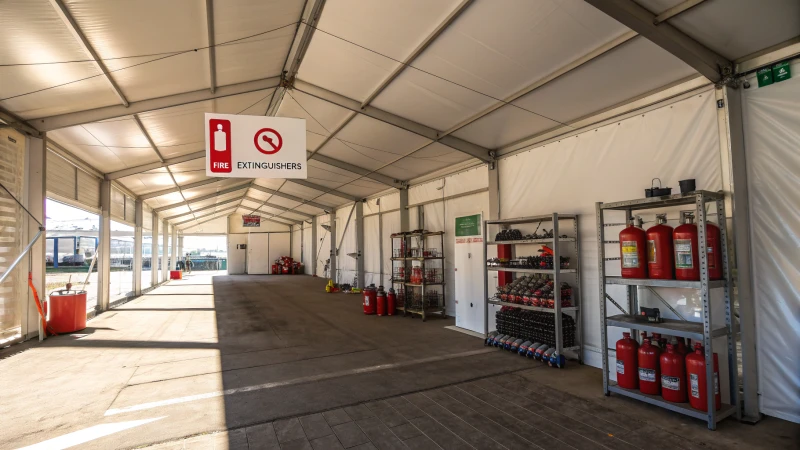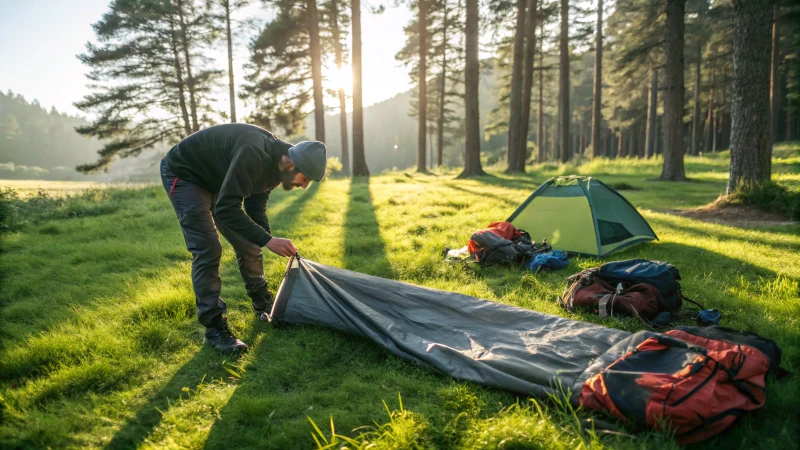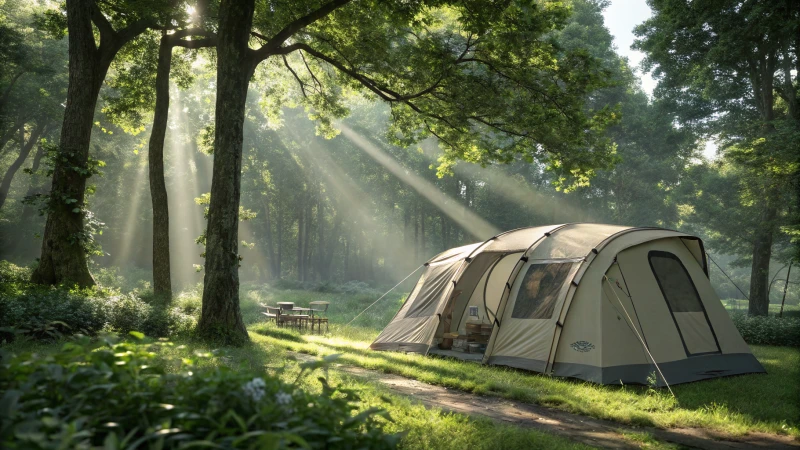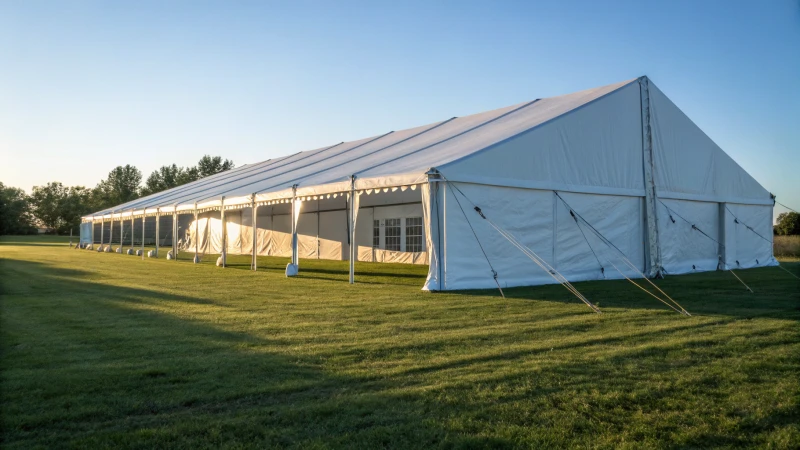
Exploring the benefits and nuances of warehouse tents can transform your storage strategy, offering flexibility and efficiency.
When considering a warehouse tent, prioritize fire safety, electrical precautions, proper storage guidelines, and weather preparation. Avoid altering the tent structure to ensure safety and longevity, tailoring the tent’s utility to fit your needs effectively.
I remember the first time I set up a warehouse tent. It felt like assembling a giant puzzle piece by piece, with each part needing careful consideration. Just like setting up camp as a kid, there’s an excitement but also a responsibility. Diving into these considerations isn’t just about following rules; it’s about ensuring that every event or storage solution runs smoothly and safely. It’s fascinating how a simple structure can offer so much versatility, and with the right precautions, it becomes an invaluable asset.
Warehouse tents are fireproof by default.False
Most warehouse tents require additional treatments to become fire-resistant.
Modifying a warehouse tent structure is discouraged.True
Altering the structure can compromise safety and void warranties.
How Can Fire Safety Measures Protect Your Warehouse Tent?
Imagine watching your warehouse tent, filled with valuable inventory, standing tall and safe against fire threats. It’s not just about peace of mind; it’s about safeguarding your investment and ensuring everyone’s safety.
To protect your warehouse tent from fire hazards, use fire-resistant materials, maintain proper ventilation, keep fire extinguishers handy, enforce no-smoking policies, and conduct regular fire drills. These precautions help safeguard both your inventory and personnel.

Understanding Fire Risks in Warehouse Tents
I remember the first time I set up a massive warehouse tent for storage. It was exciting but also nerve-wracking because I knew these fabric structures, while incredibly versatile, were also prone to fire risks. That’s why I made sure to use fire-resistant materials1 right from the start. These materials, treated with flame-retardant chemicals, can be a lifesaver, literally stopping a fire in its tracks.
Importance of Proper Ventilation
In one of my early setups, I learned the hard way how crucial proper ventilation is. We had overlooked it initially, and the buildup of heat and flammable vapors was terrifying. I quickly added vents at strategic points, which allowed for the airflow we desperately needed. This experience taught me that ventilation isn’t just a technical detail; it’s a vital safety measure to prevent fire outbreaks2.
Fire Extinguishers: Your First Line of Defense
Having easily accessible fire extinguishers in your tent is like having insurance you hope you never have to use. I once conducted an unannounced fire drill and realized that my team wasn’t entirely comfortable using the extinguishers. Since then, regular training has been a part of our routine.
| Fire Extinguisher Type | Use Case |
|---|---|
| Water | Ordinary combustibles |
| Foam | Flammable liquids |
| CO2 | Electrical fires |
| Dry Powder | Versatile for many fires |
Implementing No-Smoking Policies
I’ve always enforced a no-smoking policy within and around the warehouse tent. Trust me, it’s not just about being strict; it’s about preventing potential disasters. By designating specific smoking areas far away from the tent, I’ve managed to keep things safe and sound.
Conducting Regular Fire Drills
Regular fire drills are more than just a formality for me; they’re essential practice runs that ensure everyone knows what to do in case of an emergency. These drills help my team respond swiftly and calmly, following our carefully planned safety protocol3.
By weaving these strategies into my operations, I’ve created a safer environment for both my assets and my team. It’s about preparation, foresight, and the peace of mind that comes with knowing you’re protected from potential dangers.
Fire-resistant materials prevent rapid fire spread in tents.True
Materials treated with flame-retardants reduce fire spread risk.
No-smoking policies are unnecessary for warehouse tents.False
Smoking policies prevent accidental fires around flammable structures.
What Are the Best Practices for Storing Items in a Warehouse Tent?
Imagine stepping into a vast warehouse tent, where every inch is meticulously organized, ensuring safety and efficiency.
To store items effectively in a warehouse tent, focus on organization, safety, and climate control. Regular inspections of the tent structure and clear labeling for quick access are essential for efficient inventory management.

Organize Your Storage Space
Let me take you back to my first warehouse tent experience. It was a maze of boxes, and finding anything felt like searching for a needle in a haystack. That’s when I realized the magic of vertical storage. By stacking items using sturdy shelving units, not only did I create more space, but it also meant fewer headaches trying to find that elusive box of widgets.
Labeling became my saving grace. With color-coded labels for different categories, I could finally say goodbye to endless searches. Trust me, a little effort in labeling goes a long way in improving inventory management4.
| Item Type | Recommended Storage |
|---|---|
| Heavy Items | Ground Level |
| Fragile | Upper Shelves |
| Perishables | Climate Controlled |
Prioritize Safety Precautions
Safety wasn’t always my strong suit until an almost-accident taught me otherwise. Clear aisles are non-negotiable; they ensure smooth movement and quick emergency access if needed. And after that scare, regular checks for fire extinguishers and first aid kits became routine.
Inspect the tent’s structure for wear and tear, especially after adverse weather conditions. Secure any loose components to prevent accidents.
Manage Climate Control
I once lost an entire batch of temperature-sensitive goods due to poor climate control—a costly lesson I won’t forget. Now, dehumidifiers and fans are standard in my setup to regulate moisture and temperature.
For those of you storing sensitive items, investing in climate control systems5 is wise. They protect your inventory from damage and spoilage by maintaining ideal conditions.
Efficiently Use Layout Planning
In the world of tents, layout is everything. Creating zones for different goods or tasks optimizes workflow and reduces time spent hunting down items.
A clear pathway system with arrows or signage helps guide everyone smoothly through the space, enhancing both orderliness and safety.
Regularly reassessing the layout can lead to more efficient use of space, allowing flexibility as your storage needs evolve.
Leverage Technology for Inventory Tracking
When I first implemented digital tools for tracking inventory, it was like night and day. Barcode scanners and RFID technology minimized errors and saved countless hours.
Keeping software updated ensures you always have the latest inventory data at your fingertips, helping prevent stockouts or overstock situations.
Employing technology in inventory tracking6 not only boosts efficiency but also provides insights into usage patterns and demand forecasting—tools that have become invaluable in my business operations.
Vertical storage maximizes space in warehouse tents.True
Using vertical storage systems allows more efficient use of available space.
Heavy items should be stored on upper shelves.False
Heavy items are recommended to be stored at ground level for safety.
Why Should You Avoid Altering Your Tent’s Structure?
Ever thought about tweaking your tent’s structure for a better fit or look? Hold that thought! Making changes can lead to unexpected challenges, especially when it comes to safety and performance.
Changing a tent’s structure can weaken its stability, shorten its lifespan, and void any warranties. These modifications might also create safety hazards, particularly during bad weather.

Understanding the Risks of Modifying Tent Structures
I remember the time I decided to tweak my tent setup to make it look more appealing for an outdoor event. It seemed like a good idea until the weather took a turn for the worse. When tents are designed, each piece serves a unique purpose7. Tampering with components like poles or fabric can compromise structural integrity, leading to potential collapses during storms or heavy rain. Imagine a tent folding under pressure at a family reunion or a corporate event—that’s a scenario no one wants to experience.
Impact on Durability and Warranty
Tents are crafted with materials specifically chosen for their durability and compatibility. Replacing original parts with cheaper alternatives might seem cost-effective at first, but it drastically reduces the lifespan of the tent. I learned this the hard way after a modified tent of mine tore during an unexpected wind gust. Plus, many manufacturers have clauses in their warranties that become void if modifications are made, leaving you with hefty repair bills.
Safety Concerns in Various Conditions
A tent’s resilience against different weather conditions hinges on its original design8. Think of it like wearing a raincoat in a storm—altering the tent’s structure can compromise its ability to manage rainwater or snow effectively. I once ignored this and ended up dealing with water pooling that almost led to the entire setup collapsing!
| Factors | Risks of Alteration |
|---|---|
| Stability | Increased risk of collapse |
| Durability | Reduced lifespan |
| Warranty | Potential voiding |
| Weather Resistance | Compromised in storms |
Considerations for Maintenance and Setup
Instead of altering, focus on regular maintenance. Keep your tent fabric clean and store components properly to extend their life. If you feel modifications are necessary, consider consulting with a professional or reaching out to the manufacturer for guidance9. This ensures that any changes made are safe and won’t void your warranty.
Conclusion: Focus on Safety and Functionality
While customization might seem tempting, prioritizing safety and functionality is key. By understanding why structural changes should be avoided, you can keep your tent reliable and safe for all your adventures and events. Trust me, maintaining its original design means fewer headaches and more fun!
Altering tent poles can void the warranty.True
Most manufacturers void warranties if structural modifications are made.
Modified tents withstand snow better than original designs.False
Original designs are optimized for weather resistance, including snow.
How Do Weather Conditions Affect Warehouse Tent Stability?
Have you ever been caught off guard by sudden weather changes affecting your tent setup?
Weather conditions such as wind, rain, and snow can significantly impact the stability of warehouse tents. High winds may cause structural damage, while rain and snow can add excessive weight. Choosing the right materials and securing proper anchoring are essential for maintaining tent stability.

I remember the first time I realized how much the weather could dictate the safety and stability of a warehouse tent. It was during an event where unexpected high winds turned what should have been a smooth operation into a logistical challenge. The tent swayed more than I’d ever seen before, and it was a stark reminder of how nature can influence even the sturdiest structures.
The Impact of Wind on Tent Stability
Wind is indeed one of those unpredictable elements that can wreak havoc on tents. I’ve learned from experience that strong gusts can make even the most robust setups feel like they’re on the verge of collapse. To prevent such scenarios, I’ve always ensured that appropriate anchors10 are used, ones that can withstand unexpected wind forces. In regions where high winds are common, I recommend considering tents with reinforced frames or designs that naturally deflect wind energy. Regularly checking anchors and support lines for wear and tear has also become a routine part of my maintenance.
Effects of Rain and Snow
Rain and snow add their own challenges by piling extra weight onto the tent structure. I once faced a situation where accumulated rainwater on a flat roof almost caused a collapse. Since then, I’ve made sure to use tents with sloped roofs, which allow water and snow to slide off instead of building up. Selecting strong materials like PVC-coated polyester has also been crucial because they handle these loads effectively.
Here’s a handy comparison of materials based on their load capacity and weather resistance:
| Material | Load Capacity | Weather Resistance |
|---|---|---|
| PVC-coated Polyester | High | Excellent |
| Nylon | Moderate | Good |
| Canvas | Low | Fair |
Temperature Extremes and Structural Integrity
Temperature extremes have their own set of challenges. I’ve noticed how high heat can weaken materials, while cold can make them brittle. Opting for materials with temperature-resistant properties11 has been a game-changer for me. For temporary setups in extreme climates, modular designs that allow for easy component replacement have proven invaluable.
Best Practices for Enhancing Stability
To ensure the durability and safety of warehouse tents, there are several best practices I follow:
- Regular Inspections: I routinely check all components to ensure they’re intact and functional.
- Adaptive Design: Choosing tents that offer flexibility in configuration and reinforcement options has made adapting to different environments much easier.
- Environment-specific Features: Incorporating features like adjustable venting or solar reflectors has helped manage climate control effectively.
By adhering to these practices, I’ve been able to enhance the durability and safety of warehouse tents across various weather conditions, ensuring that my operations continue smoothly.
Reinforced frames improve tent stability in high winds.True
Reinforced frames help deflect wind energy, enhancing stability.
Nylon is the best material for weather resistance in tents.False
PVC-coated polyester has higher weather resistance than nylon.
Conclusion
When using warehouse tents, prioritize fire safety, avoid structural modifications, ensure proper ventilation, and prepare for weather conditions to maintain stability and protect your inventory.
-
Discover the best materials for enhancing fire safety in tents, ensuring protection against rapid fire spread. ↩
-
Learn about the role of ventilation in preventing fires and promoting airflow in tent structures. ↩
-
Explore comprehensive fire drill strategies to enhance readiness and ensure safety in emergencies. ↩
-
Explore how labeling systems enhance inventory management by improving accessibility and organization. ↩
-
Discover effective climate control solutions that safeguard temperature-sensitive goods. ↩
-
Learn about technologies that streamline inventory tracking and boost warehouse efficiency. ↩
-
Understanding the purpose of each component helps maintain structural integrity when using tents. ↩
-
Knowing how design affects weather resistance ensures tents perform well under adverse conditions. ↩
-
Professional guidance ensures modifications do not compromise safety or warranty. ↩
-
Discover reliable anchoring solutions to secure warehouse tents against strong winds, ensuring stability and safety. ↩
-
Learn about tent materials designed to withstand extreme temperatures, enhancing durability and longevity. ↩








